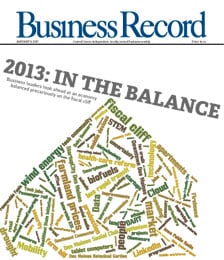Tax credits boost downtown

The developer of one of Des Moines’ first mixed-income apartment complexes near downtown says he’s proven the concept will work to spur urban housing in Des Moines. Less than six months after opening, the Woodland Avenue Brickstone is 96 percent rented.
“The lesson we learned from that was very simple,” said Jack Hatch, the project’s developer. “People want to live downtown.”
The 56-unit apartment building in Sherman Hill was also one of the first mixed-income projects in the state to receive low-income tax credit financing through the Iowa Finance Authority. I think we’re going to see more (mixed-income projects), said Tim Waddell, the IFA’s tax credit manager, “as developers look to use us as a funding source, but not a total funding source.”
This week, Hatch will find out if his next mixed-income housing project, called East Village Square, will qualify for the $3.2 million he’s applied for in tax credits. The finance authority meets on Wednesday to decide which projects out of 48 applicants statewide will receive $6.6 million for this year’s round of financing.
“It’s a 9 percent credit, but we give it for 10 years,” Waddell said. That means a $1 million project, for instance, would receive a $100,000 tax credit.
The state’s 2004 allocation includes $514,637 that will be recommitted to the Vine Street Lofts, another mixed-income project in Des Moines, which is being rebuilt after the nearly completed structure was destroyed a year ago in a fire.
The low income tax credits provide a dollar-for-dollar reduction to offset an owner’s federal tax liability on ordinary income. By selling the credits to investors or syndicators to generate equity for their projects, developers often use them as the final financing piece to make a project viable.
The credits are usually sold to investors at a discount of between between 78 and 85 cents on the dollar. Because investors’ tax credits would be recaptured by the IRS if the project defaults, investors tend to choose their projects carefully, Waddell said, and that has resulted in very low foreclosure rates and low risk to investors.
For Hatch’s East Village Square project, Knapp Properties Inc. will own the 28 condominium units. The Neighborhood Investment Corp., a non-profit corporation with the mission of developing projects for neighborhoods, will own the 105 apartment units. U.S. Bank Community Development Corp., which invested $1.2 million in the Brickstone project, would also like to invest in the East Village project, Hatch said.
“The exciting thing about the NIC is that half the money made has to be reinvested back into the neighborhood,” he said. “It’s that element of our development philosophy that’s exciting, that it’s building financial capacity, so they rely less on public money.”
With the Brickstone project, “we also learned that we can get the rents we were hoping for,” he said. The rents for the one-bedroom apartments range from $690 to $720, with the two-bedroom units renting at between $880 and $990. Twenty-five percent of the units must be rented to families earning less than $22,500 a year, which is 50 percent of Polk County’s median income. The 1-bedroom low-income units rent for $483 per month.
The design is eye-catching as people pass the apartments along 15th Street.
“People like the design,” Hatch said. “We designed them a little bit differently, like the brownstones of Philadelphia or Baltimore. They are meant to be an urban structure.
“I think with everybody, from the banker to the renter, has been happy with this project. It has proved that people can live downtown,” he said. “Second, it has shown the lower-income person can have an apartment the same as a market-level apartment, and the mixture seems to work.”
TAX CREDIT PROGRAM
Created by Congress as part of the Tax Reform Act of 1986, the Low Income Housing Tax Credit program has resulted in the creation of more than 12,000 low-income apartment units in more than 400 projects throughout Iowa. Each year, the state receives an allocation of tax credits that are then distributed by the Iowa Finance Authority. Projects are chosen based on a scoring system. Generally, in Iowa the ratio of applicants to awards has been 3-to-1, making it a competitive process.
The credits are available to individuals, corporations, and partnerships for new construction, substantial rehabilitation, or acquisition and rehabilitation of LIHTC projects.






